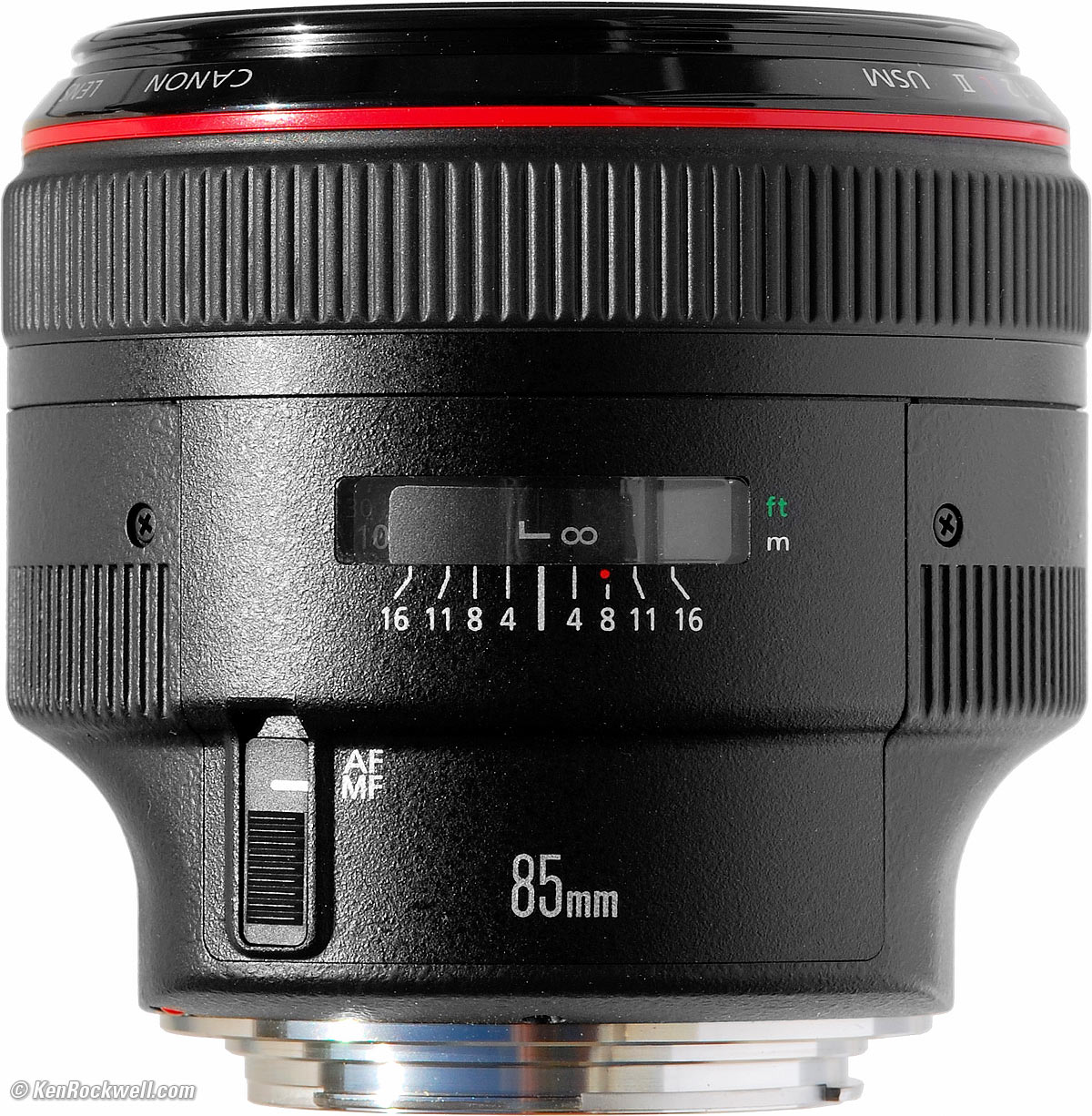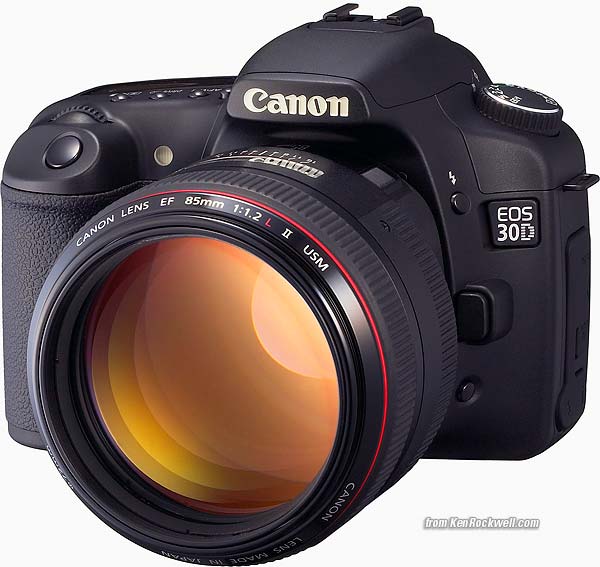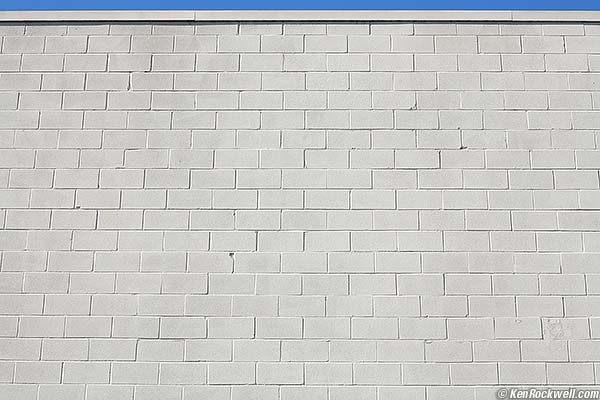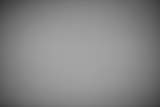Home Donate New Search Gallery Reviews How-To Books Links Workshops About Contact
Canon 85mm f/1.2L II
© 2007-2023
KenRockwell.com. All rights reserved.
Intro Specs Performance Recommendations
Canon EF 85mm f/1.2L II USM (72mm filters, 34.2 oz./971g), about actual size. enlarge. About $1,000 used if you know How to Win at eBay, and also available used at Amazon.
This all-content, junk-free website's biggest source of support is when you use those or any of these links to approved sources when you get anything, regardless of the country in which you live. Thanks for helping me help you! Ken.
March 2023, November 2013, February 2007 Canon Reviews Canon Lenses All Reviews
Canon EF 50mm f/1.0 L USM (same exterior parts, 1989-2000)
Good
1.) Exquisitely sharp and contrasty, even wide open, even in the corners, and even on full-frame.
2.) Exquisitely well made.
Bad
1.) Slow autofocus, needed for accurate f/1.2 focusing.
2.) Clumsy, indirect electronic manual focus.
3.) Doesn't focus very close, only 3.2' (0.95m).
4.) Slightly more flare than the Canon 85mm f/1.8.
4.) Huge.
5.) Heavy.
6.) Expensive.
Top Specs Performance Recommendations
This huge aspherical Canon EF 85mm f/1.2L II USM offers spectacular image quality, even at f/1.2, for professional journalists and amateur astronomers.
This lens is designed for 35mm EOS and DSLRs. It works great on mirrorless with an EF to RF adapter. Its autofocus was always very slow and precise, optimized more for scientific and astronomical use rather than journalism. Today, the RF 85mm f/1.2 lenses and the EF 85mm f/1.4 L IS USM have much faster autofocus.
See the teeny little lens mount on the left in the photo? That's the same standard Canon EF mount as normal lenses. It looks tiny because this lens is much bigger around than the lens mount.
This isn't your grandfather's conventional 85mm f/1.2, and this isn't a lens to use for general photography. It listed for $2,100 US, and sold for about $1,800 US when it was new.
This grapefruit-sized behemoth is a very special purpose lens designed for people who intend to use it wide open most of the time, and are willing to pay for that in many ways. You people know who you are. If you have to ask, then this lens isn't for you. If you know who you are and think you need one of these, go get one today. Its optics are extraordinary, even wide open. Point sources of light stay points, even at f/1.2 in the farthest corners, even full-frame. Most of this review is written for normal people explaining why this lens is great, but mostly for crazies like you.
For general photography, the smaller Canon 85mm f/1.8 works better. I reviewed the excellent f/1.8 at the same time as this f/1.2, but I still need to write it up. For most people, even if someone was giving these away for free, the 85mm f/1.8 is a better lens because it focuses faster, focuses more easily, focuses closer, has less flare, weighs a lot less and is just as sharp.
If you're a collector-user who values the best more than you value practical utility, there isn't any real downside optically to this f/1.2 lens versus the more practical f/1.8. You'll love this beast if you don't mind hauling it around.
If you need to shoot at wider than f/1.8, I've never used anything else like this f/1.2 lens. Image quality is spectacular, presuming you know the limitations of shooting and focusing at f/1.2.
Even though it excels at photographing test charts even at f/1.2, in real photography the depth of field is paper-thin, so at f/1.2 almost nothing is in focus. Your camera's autofocus system will be taxed to its limit and you'll have a tough time getting your intended subject in focus if you're worrying about lab-grade sharpness. It won't happen unless you're subject is flat, which is only test charts or skies.
You can't manual focus accurately enough for f/1.2 because the standard focus screens on the Canon 5D and others only see at a maximum of f/2.5 - you need a special focus screen for precise manual focus. I'm not kidding: flick the field preview and you won't see any change stopping down to f/2.5. That's the way modern laser-etched finder screens are made to make dim zooms look brighter. You'll do OK for journalism, so long as you set focus to the middle of what looks sharp.
I have to underscore that this is a very special purpose lens. Get it in a heartbeat if you need to shoot wider than f/1.8, but skip it in favor of the 85mm f/1.8 if you shoot at more reasonable apertures like f/2.
Lenses like this also emphasize that you get what you pay for from Canon. Canon makes lenses for television, motion pictures and semiconductor manufacturing that run six-, and maybe even into seven-figure price tags. When you drop two grand on this lens, you'll feel it. It's got a lot of metal instead of plastic. Look in the back: internal lens groups ride on roller bearings; they don't just slide around in tubes!
Let me reiterate that it's huge, about the size of a grapefruit, and a lot heavier. When you put this on your camera, you're actually putting your camera on the back of a lens much bigger and heavier than your camera. It will feel very front-heavy. Here's a promo shot of it on a Canon 30D:
Canon 85mm f/1.2L II on a 30D. It looks cool, but fills two hands.
Top Introduction Performance Recommendations
Name
Canon calls this the CANON LENS EF 85mm f/1.2 L II USM.
EF: Electronic Focus. All modern Canon lenses focus with a motor in the lens.
L: Expensive as L. No exact meaning other than this being Canon's lingo for lenses with extra durability and weather sealing. L lenses work on all cameras including film and full-frame digital. Canon puts a red band around the front of these.
II: Canon's second version of this lens. There is an older version, introduced in 1989, called CANON LENS EF 85mm f/1.2 L USM, without the "II."
USM: Ultra-Sonic Motor: The focus motor operates silently.
Optics
8 elements, 7 groups.
Modified double-Gauss.
One element is an expensive ground and polished aspherical element. The precision aspherical element eliminates the aberrations common to conventional spherical high-speed optics. It's also why it costs two grand!
Focal Length
85mm.
Used on a 1.3x camera it gives an angle of view similar to what a 107mm lens would give on a 35mm film camera. On a 1.6x camera it gives an angle of view similar to what a 138mm lens would give on a 35mm film camera. See also Crop Factor.
Diaphragm
8 blades, stopping down to f/16. Round to f/2.0, octagonal from f/4 up.
Filter Size
72mm.
Close Focus
3.2' (0.95m) from the image plane (the back of the camera), marked.
Maximum Reproduction Ratio
1:9.1
Infrared Focus Index?
Yes, for 800nm IR.
Size
About as big as a grapefruit. 3.6000" diameter x 3.306" extension from flange (91.44 x 83.97mm) at infinity; 3.815" (96.90mm) extension at close focus stop.
Weight
34.245 oz. (2 pounds, 2-1/4 oz. or 970.9g), measured, naked.
Hood
ES-79II, snap-on flocked plastic, included.
It rotates during manual focus, and stores on the lens reversed.
Case
LP1219 pouch, included.
Introduced
February 2006.
Discontinued
Gone in March 2023.
Price, USA
March 2023
About $1,000 used if you know How to Win at eBay, and also available used at Amazon.
Christmas 2013
Deal: Canon 85mm f/1.2L II USM for $1,799: Price at Checkout is $1,999.00 and Final Price after mail-in-rebate is $1,799 — with Free Shipping!
2007 (introduction)
It listed for $2,100 US, and sold for about $1,800 US when it was new.
Top Introduction Specs Recommendations
Autofocus Bokeh Color Color Fringes Construction
Distortion Eyeblow Falloff Film Filters Flare Flash
Macro Serial # Sharpness Sunstars IS
It's a huge hunk of glass. It feels weird on-camera. It weighs 36% more than the 70-200mm f/4L, and is a lot shorter. My camera always feels like it wants to flop forwards.
AF is slow, and manual override is a weird indirect electronic system.
It is a masterpiece of manufacturing. It reeks of quality and precision, and its images are extraordinary.
Focusing back to Performance or back to Introduction.
The focus is slower and clumsier than other lenses, and much clumsier than the inexpensive 85mm f/1.8.
What Moves
The front group moves but does not rotate. The rear elements are fixed.
The hood snaps onto the manual focus ring, which of course rotates during manual focus.
Speed
AF speed is slow, slower than the 85mm f/1.8. This f/1.2L II version is much faster than the first 1989 f/1.2L version. Canon says this new version is 1.8x faster than the original f/1.2, but it's still slower than the f/1.8 I tried.
This is because the system needs to be much more precise than other lenses to ensure accurate focus at f/1.2. Depth of field at f/1.2 is a few inches (5 cm) at one hundred feet (30m), so extreme AF accuracy is required to make real use of the f/1.2 aperture.
The lens needs to be positioned mechanically within distances measured in wavelengths of light, so this takes a while longer than less precise, slower f/stop lenses.
Sound and Noise
It's almost silent. It makes a slight sliding noise as it moves, with almost no clunking.
The manual focus ring sounds nice when spun with the camera off. It makes a super high precision encoder sound, if you listen for those things.
Ease of Manual Focusing
Weird. It's like my 10 year old Nikon AF-I lenses: when you grab the ring, an electronic system cuts in and spins the internal focus for you! It's a weird disconnected feeling. The electronics don't always track exactly your turning of the focus ring. If you spin it fast, the lens can't keep up, but that's not a problem.
It's much better than the previous 85mm f/1.2L.
It's 3/4 of a turn from infinity to the close focus of 0.95m.
You don't need to move the switch; it's automatic.
Manual focus only works when attached to a camera that's turned on. No camera, or camera off, and no manual focusing. This means be sure to focus at infinity before you remove it from your camera if want the lens as compact as possible (ha ha) before throwing it in your bag. When removed from a camera, the manual focus ring spins without focusing the lens.
I prefer the direct mechanical clutch system in most of the other Canon USM and Nikon AF-S lenses, like the Canon 85mm f/1.8.
The f/1.2 does what it does because it has to to retain the extreme mechanical precision required for edge-to-edge sharpness at f/1.2 for astronomy.
Since manual focus is actually electronic, it would be innovative if Canon offered a remote control for manual focus for astronomical use. (Patent disclosure here, I'd love to be named on any filings, thanks!)
Caution: you'll want to look for the green focus confirmation dot in the finder (in which case you'd be better off with AF) or use a special high-precision manual focus screen. The standard focus screens in AF cameras are optimized for brightness with modern f/2.8 and slower zooms.
Standard focus screens therefore aren't ground glass; they are laser-cut with special patterns that only see though the lens at about f/2.5. Want to see this? Stop the lens down with the field preview button. You won't see any dimming until you get to f/2.5. That's right: this lens looks no brighter than an f/2.8 lens through the finder! You also can look at the finder screen through the front of the lens. You'll see a weird image: you'll only see the light coming through the finder screen in a circle where the diaphragm would lie at f/2.5. The rest is dark, if you're looking through the camera from the front.
The special manual focus screens available for some Canon cameras use traditional ground glass to let you see more accurately at f/1.2.
See Canon 5D Focus Screens for more.
Autofocus Accuracy
AF accuracy is quite good and consistent.
If you're really looking for problems, like shooting at f/1.2 in broad daylight, my 5D focuses consistently a little behind the intended subject. At 100' (30m) it focused about a foot (30cm) too far, which is beyond the depth of field No big deal, because:
a.) I've heard Canon will tweak any camera and lens combo under warranty one time, for free, to get this perfect, and
b.) After a few shots, I realized I could focus on something a foot closer at that distance, and get reasonably perfect focus on the intended target. My 5D tends to focus a little closer than the subject with other ultrafast lenses, so it's most likely a need to tweak my 5D, not the lens.
c.) If my camera focuses an 85mm lens a foot (30cm) too far for a subject at 100' (30m), that is only a three micron error at the image plane. 3u is 1/10,000 of an inch, or six wavelengths of light.
Focus Breathing
Breathing is a motion picture term which refers to what happens as you pull (change) focus from near to far. I list this for people putting these lenses on their Canon XL-1s for shooting video.
The Canon 85mm f/1.2 L II changes magnification as it focuses, like most still camera lenses.
Bokeh back to Performance or back to Introduction.
Caution: as explained above under manual focusing, most modern cameras, like my 5D, only show a view through the lens equivalent to f/2.5. Your actual photos will show very different results from what you see in the finder at large apertures. You may want to consider the high precision manual focus screen, and if you do, be sure to set your camera accordingly. This is set in custom function 00 in my 5D.
Bokeh is good. It's quite neutral, a pleasant surprise since many other advanced aspherical optics of this class usually have hideous bokeh in their unrelenting pursuit of sharpness. Here are full-frame images from my 5D focused at 10 feet (3m). The woods are at about 50' (15m):
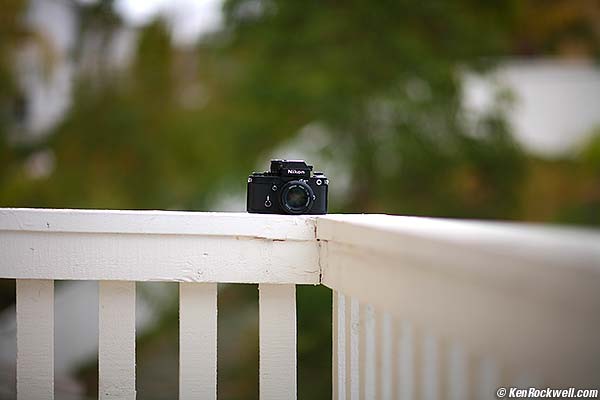
Full frame, Canon 85mm f/1.2 at f/1.2.
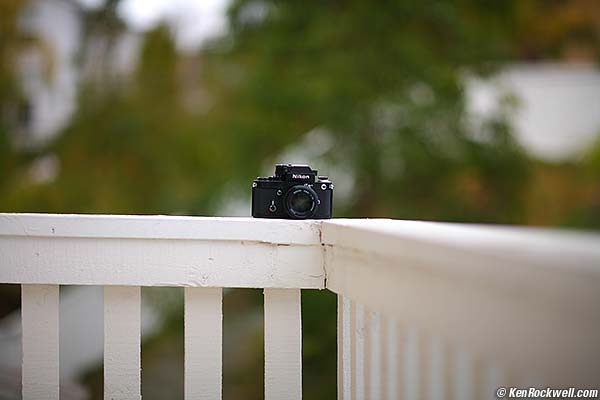
Full frame, Canon 85mm f/1.2 at f/1.4.
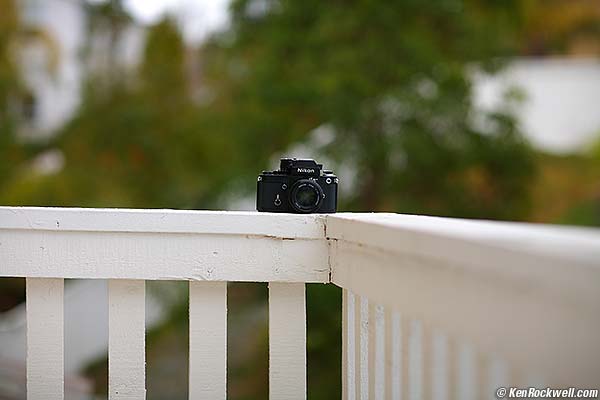
Full frame, Canon 85mm f/1.2 at f/2.
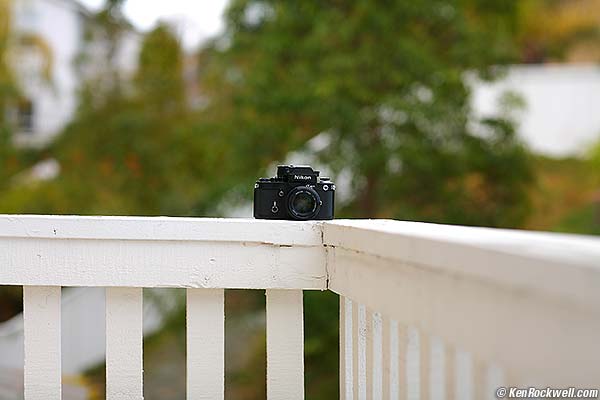
Full frame, Canon 85mm f/1.2 at f/2.8.
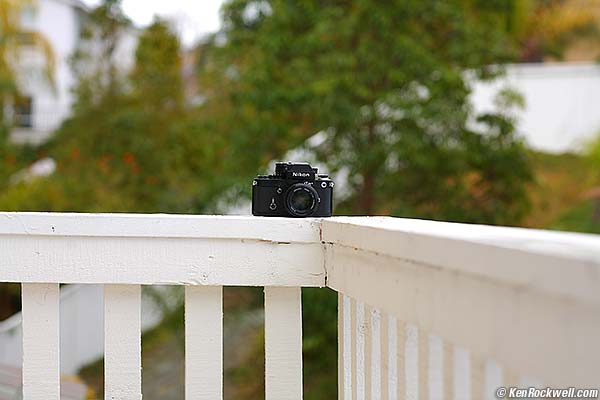
Full frame, Canon 85mm f/1.2 at f/4.
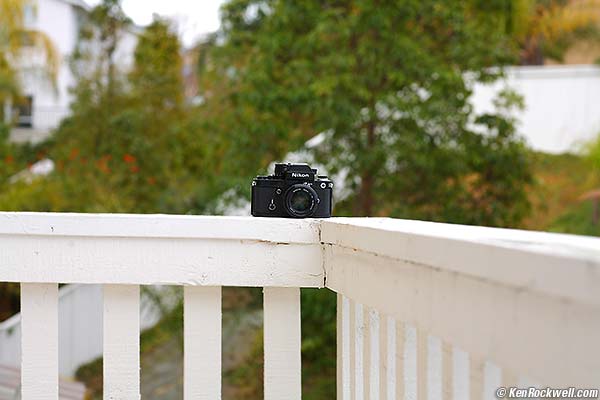
Full frame, Canon 85mm f/1.2 at f/5.6.
Bokeh at the smaller apertures is better than it looks here. The little bokeh blobs at f/4 and f/5.6 just happen to be far enough apart so that the edges here (but not centers) overlap and are making the good bokeh look bad.
Lateral Color Fringes (LCA)
back to Performance or back to Introduction.
The Canon 85mm f/1.2 L II is excellent. It has no color fringes, unless you're slightly out of focus, which is axial chromatic aberration, a different issue that means you're out of focus.
This lens is approved by the PPLFPA, Professional Patio and Lawn Furniture Photographers' Association, with a grade of "A."
Here's a full-frame image from my 5D:
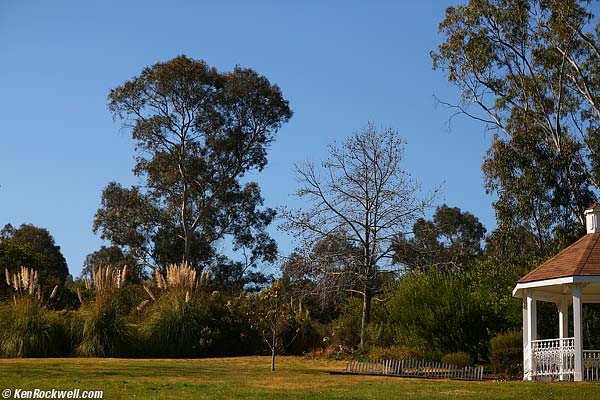
Full image, Canon 85mm f/1.2 II at f/2.8.

Unsharpened crop from the above at 100% magnification.
The right edge of this crop goes right to the very edge. There is no color fringing, period, so long as you're in perfect focus. Note how sharp this is at f/2.8; it's just as sharp at f/1.2!
See also the examples at Sharpness.
Color Rendition back to Performance or back to Introduction.
I see no differences from my other Canon lenses.
back to Performance or back to Introduction.
Most Exterior Barrel Parts
Plastic. Front groups' barrel is metal.
Filter Threads
Metal.
Focus Ring
Metal covered with a band of ribbed rubber.
Markings
Silver paint.
Switches
Plastic.
Mount
Metal.
Internals
Metal.
Have a look into the rear: you'll see a lens group that rides on three roller bearing! Canon's not playing around with this lens.
Noises when shaken
Lots of klunking. This is normal. If you hold the front group and focus ring you get much less noise: you'll only hear the diaphragm blades softly moving as you shake it.
Quality
Made in Japan.
Distortion back to Performance or back to Introduction.
Distortion is minor barrel distortion. It's invisible for anything you ought to be shooting with this lens.
Plug +0.5 into Photoshop CS2's lens distortion filter to correct the distortion. This figure is for you to enjoy in your photography. This took me hours to calculate and is © and registered, so you'll need permission to use it for anything else. Thanks! Ken.
Here's the Wall of Shame. Roll your mouse over it to see after correction in Photoshop.
The Wall of Shame. Roll your mouse over it to see after correction in Photoshop.
back to Performance or back to Introduction.
No air blows out of my viewfinder as I focus. The Canon 85mm f/1.2L II USM has a fixed rear element, so no air blows out its rear.
This helps keep your digital camera sensor cleaner than zooms, which can pump air in and out as you zoom.
back to Performance or back to Introduction.
Here are shots of an Expodisc on my full-frame 5D. These results will be better on a 1.3x camera (1D), and much better on a 1.6x camera like a 30D (more at Crop Factor).
|
This test exaggerates what I saw shooting. This is a tough test which shows even the slightest falloff. Except at f/1.2, I never saw any of this in real photography.
There is falloff at f/1.2, but unless you're shooting in broad daylight, it doesn't matter. For shooting the things you're likely to shoot with this special lens at f/1.2, it looks fine. Astronomers do take note, however.
These shots are in my 5D's aperture-preferred auto (Av) mode. The camera's meter and the calibration of the blades gave darker results wide open. This is OK, I'd be ticked if the system overexposed the shots at f/1.2, which would be wasting very expensive light. This way it effectively "pushes" the image a little (may need some lightening later) and gives me even faster shutter speeds when I really, really need them at f/1.2. If this slightly darker rendition isn't for you, simply dial in some positive exposure compensation at wide apertures.
Lest you think that the slightly darker f/1.2 image means Canon is cheating you out of your true f/1.2; I checked it directly against a Canon 85mm f/1.8, and the f/1.2 indeed transmitted a full stop more light at f/1.2 than the other lens did at f/1.8.
The results from the f/1.2 lens look darker than they are because of the falloff in the corners.
Canon 85mm f/1.2L II Review Continues > >
Help me help you top
I support my growing family through this website, as crazy as it might seem.
The biggest help is when you use any of these links when you get anything, regardless of the country in which you live. It costs you nothing, and is this site's, and thus my family's, biggest source of support. These places have the best prices and service, which is why I've used them since before this website existed. I recommend them all personally.
If you find this page as helpful as a book you might have had to buy or a workshop you may have had to take, feel free to help me continue helping everyone.
If you've gotten your gear through one of my links or helped otherwise, you're family. It's great people like you who allow me to keep adding to this site full-time. Thanks!
If you haven't helped yet, please do, and consider helping me with a gift of $5.00.
As this page is copyrighted and formally registered, it is unlawful to make copies, especially in the form of printouts for personal use. If you wish to make a printout for personal use, you are granted one-time permission only if you PayPal me $5.00 per printout or part thereof. Thank you!
Thanks for reading!
Ken Rockwell.
Home Donate New Search Gallery Reviews How-To Books Links Workshops About Contact

